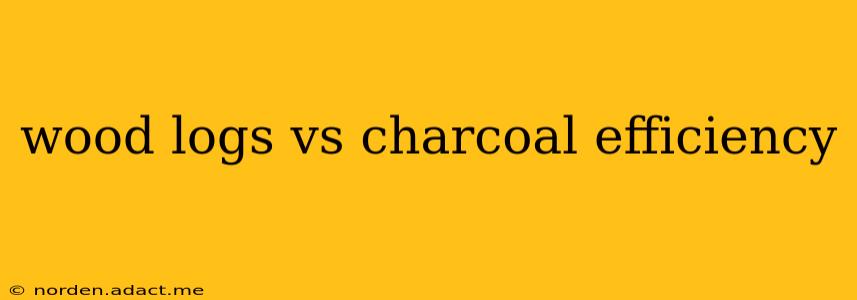Choosing between wood logs and charcoal for cooking or heating involves considering several factors beyond just price. While both are biomass fuels derived from wood, their efficiency differs significantly in terms of heat output, burn time, ease of use, and environmental impact. This comprehensive guide explores the key differences and helps you determine which fuel best suits your needs.
What is the difference between burning wood logs and charcoal?
The primary difference lies in the processing. Wood logs are simply pieces of wood, typically cut and seasoned for optimal burning. Charcoal, on the other hand, is produced by heating wood in the absence of oxygen, a process called pyrolysis. This process removes most of the moisture and volatile compounds, resulting in a denser, carbon-rich fuel.
Which is more efficient: wood logs or charcoal?
Determining which is more efficient depends on the context. Charcoal generally burns hotter and more consistently than wood logs. This translates to faster cooking times and a more controllable heat source, particularly advantageous for grilling and barbecuing. However, wood logs offer a longer burn time, making them a more cost-effective choice for extended heating applications like fireplaces or wood-burning stoves, especially if you have access to a readily available and affordable supply of wood.
How long does a wood log burn compared to charcoal?
The burn time of both fuels varies considerably depending on factors like size, wood type (for logs), moisture content, and airflow. Generally, a single wood log can burn for several hours, while a comparable amount of charcoal might last only a few hours at high heat. However, charcoal’s intense heat allows you to cook more efficiently in the time it burns.
What are the pros and cons of using wood logs?
Pros:
- Cost-effective (often): Depending on your location and access to wood sources, logs can be significantly cheaper than charcoal.
- Longer burn time: Ideal for extended heating needs.
- Renewable resource (if sustainably sourced): When harvested responsibly, wood is a renewable fuel source.
- Produces a unique flavor (for cooking): Imparts a smoky flavor to food.
Cons:
- Inconsistent burn: Can be difficult to control the heat output.
- Requires more preparation: Needs seasoning and stacking.
- Produces more smoke and ash: Can be messy and less environmentally friendly than charcoal (depending on wood source and burning practices).
- Moisture content affects burn: Wet wood burns poorly.
What are the pros and cons of using charcoal?
Pros:
- Higher and more consistent heat: Excellent for grilling and barbecuing.
- Easier to control: Simpler to manage the heat levels.
- Produces less smoke (generally): Cleaner burning than some types of wood.
- Convenient to use: Readily available in briquettes or lump form.
Cons:
- More expensive: Generally more costly per unit of heat than wood.
- Shorter burn time: Requires more frequent refueling for extended use.
- Not a renewable resource (unless sustainably produced): Production involves significant energy and resources.
Is charcoal better for grilling than wood?
For most grilling applications, charcoal offers significant advantages. Its consistent, high heat makes it ideal for searing, achieving even cooking, and controlling the char on food. While wood grilling imparts a distinct flavor, charcoal provides greater control and predictability in the cooking process.
What are the environmental impacts of burning wood vs. charcoal?
Both wood and charcoal burning release greenhouse gases. The environmental impact depends heavily on sourcing and burning practices. Sustainably sourced hardwood logs have a smaller carbon footprint than charcoal, which requires energy-intensive production. However, inefficient burning of either fuel can negate these advantages. Minimizing emissions requires efficient combustion and responsible forest management.
Conclusion
The “better” fuel—wood logs or charcoal—depends entirely on your needs and priorities. Charcoal excels in applications demanding high and consistent heat, while wood logs are a more economical option for extended heating with a readily available supply of wood. Consider factors like cost, heat requirements, convenience, and environmental impact to make an informed decision.
